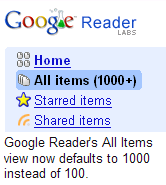Google Reader improvements leave more room for improvement

For the first time since coming back from vacation earlier this week, I finally took the plunge and looked at my RSS reader. Like coming back to e-mail, it's a moment I've been dreading because, with all of my subscriptions (I keep whittling them down, but that doesn't seem to help), my RSS reader is like a black hole that I often disappear into for several consecutive and highly unproductive hours as I try to clear the deck of the noise I'd rather not see. I've tried lots of RSS readers. But Google Reader is still the one I come back to and am loyal to, despite its foibles. It's fast, accessible from anywhere, and does smart things.

I didn't think much of the new 1000 item threshold until, in the course of digging through all those items, I found Robert Scoble glowingly thanking Google for thenew and improved Google Reader. The big change is the addition of search. I liked Tom Raftery's take on it:
...the search functionality rolled out is extensive allowing searching of individual feeds, all feeds, or by folder lavel....Google Reader’s only serious competition, Bloglines needs to do something drastic or it will lose out completely to Google.
I hadn't thought of Google Reader with search as being a potential competitor to Bloglines or Technorati. But Raftery's insightfulness is dead on. I'm just imagining what some mashup developer could do with Google Reader Search under the hood.
So, has Google reached its promised land? Are they done? Personally, I don't think so. A lot of people talk about how efficient the Google Reader is. But, if intuition is your guide (as it should be with many user interfaces), then I don't necessarily agree. UI intuition is largely driven by our experience with other applications and over the years, de facto standards have emerged for how the user interface responds to certain keyboard events. In most applications, when the down arrow key is pressed, you move to the next line. That could be the next line in a word processor or the next line in a spreadsheet or some other list.
In Google Reader, intuition tells us that the down arrow will take us to the next RSS item in the list But it doesn't. It simply scrolls the scroll bar down a notch. My developer friends tell me that although Google probably has the resources to fix this problem (Google Spreadsheets for example can trap "arrowing events"), that it really isn't Google's fault as much as it is a fact of life for browser-based applications.
Given that the act of RSS reading is about efficiently filtering and digesting information, the biggest challenge for the publisher of any RSS reader (Google or otherwise) is user productivity. If you're relying on intuition to productively get you through the Google reader interface, then, you'll end up as I was with it: very unproductive. For example, to rapidly trim my unread items list down to something manageable, intuition tells me that I should see a checkbox next to each item (like you see in a lot of mail products including Google Mail) and then I should just be able to, with one more keystroke, mark them as having been read, and refresh the page (so that all that remains are the unread items). Maybe your intuition is telling you something else. In either case though, intuition doesn't work.
What does work is magical once you get used to it are Google Readers' keyboard shortcuts. For example, to scroll forwards through items without toggling their "unread" status to "read," you press the "n" key ("n" is for next). The "p" key (for previous) goes the other direction. To mark items as read (as though you opened them), you press the "m" key (for mark). While the key selections make sense, it something that you might never intuit until someone told you about all the shortcuts (and the shortcut to finding them). One nice touch: the question mark key gets you the list of shortcuts.
So, one of my requests to Google is to throw some of its pixie dust on the user interface to make it more intuitive (even though I know the shortcuts, that doesn't mean everyone will and I can imagine some hardware where keyboard shortcuts would end up being longcuts). Another is to make Reader available in some way to the users of Google Apps. Right now (as far as I know), if you're logged in as a user of Google Apps, you can't use that same Google identity to access Google Reader (if you know differently, please let me know).
Finally, the desktop app fan-boys (and girls) are probably tired of me saying this, but coming home to an upgraded Google Reader the way I did is in fact, one of the beauties of net delivered browser-based applications. It was as if the IT department was working on my computer while I was gone. I came home, turned on my PC, opened Google Reader a few days later and, without lifting one finger (no CDs, downloads, installations, uninstallations, etc.), the new version was staring me in the face. Even better, if I don't like it, for a limited time (through Reader's preferences), I can revert to the old version with a single click. In a nutshell, that refresh button is one special button when it comes to upgrading browser-based software.